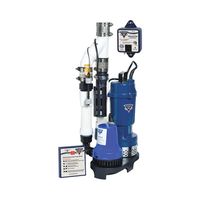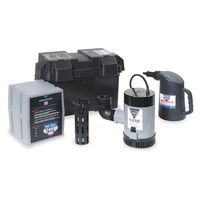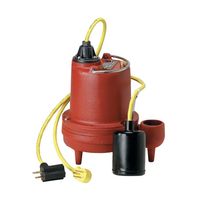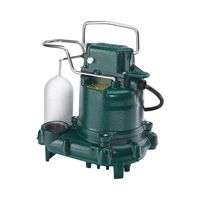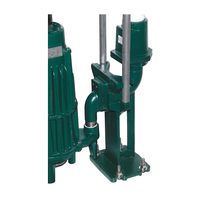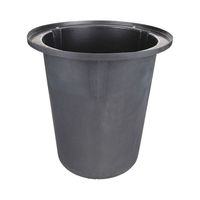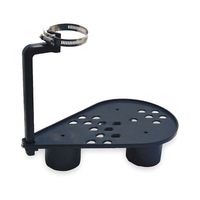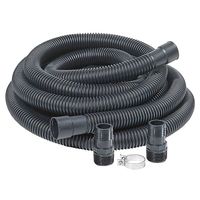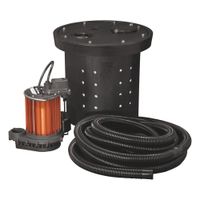Call +(254) 703 030 000 / 751 483 999 / 721 704 777
- Home
- Pumps
- Sump Sewage Utility Pumps
- Sump Pumps
Sump Pumps
Back-up sump pumps provide additional hours of protection against flooding when the primary pump stops operating due to mechanical failure or an electrical power outage. High-temperature submersible sump pumps transfer hot liquids such as furnace condensate or waste from boiler blowdown. Primary sum .....Read More
Frequently Asked Questions
What is a backup sump pump and how does it work?
A backup sump pump is a secondary pump system designed to provide additional protection against basement flooding in the event that the primary sump pump fails. It is typically installed alongside the main sump pump in the sump pit, which is a basin located in the lowest part of a basement or crawl space. The primary function of a backup sump pump is to ensure that water is effectively removed from the sump pit when the main pump is inoperative due to power outages, mechanical failure, or overwhelming water inflow.
There are two main types of backup sump pumps: battery-powered and water-powered.
1. **Battery-Powered Backup Sump Pump**: This type uses a rechargeable battery to operate. When the primary pump fails, the backup pump automatically activates, drawing power from the battery to pump water out of the sump pit. The battery is typically a deep-cycle marine battery, designed to provide power over an extended period. Some systems include alarms to alert homeowners when the backup pump is in use or when the battery needs charging or replacement.
2. **Water-Powered Backup Sump Pump**: This type relies on the home's municipal water supply to function. It uses water pressure to create a vacuum that draws water out of the sump pit. This system does not require electricity or batteries, making it a reliable option during power outages. However, it requires a consistent and adequate water supply and may not be suitable for homes with well water.
Both types of backup sump pumps are crucial for preventing water damage, mold growth, and structural issues in basements, providing peace of mind to homeowners by ensuring continuous operation even during adverse conditions.
How long does a backup sump pump last during a power outage?
The duration a backup sump pump lasts during a power outage depends on several factors, including the type of backup system, the battery capacity, the frequency of pump cycles, and the amount of water entering the sump pit.
1. **Battery-Powered Backup Sump Pumps**: These are the most common type of backup systems. The longevity of a battery-powered sump pump during a power outage is primarily determined by the battery's amp-hour (Ah) rating. A typical deep-cycle marine battery with a 75 Ah rating can last anywhere from 5 to 7 hours of continuous pumping. However, if the pump cycles intermittently, it can last for 1 to 3 days, depending on the frequency and duration of each cycle.
2. **Water-Powered Backup Sump Pumps**: These systems use municipal water pressure to operate and do not rely on electricity or batteries. As long as there is adequate water pressure, they can run indefinitely. However, they require a reliable municipal water supply and are less effective in areas with low water pressure.
3. **Frequency of Pump Cycles**: The more frequently the pump needs to cycle, the shorter the battery will last. During heavy rainstorms, when water is entering the sump pit rapidly, the pump will cycle more often, reducing the battery's lifespan.
4. **Battery Maintenance and Age**: A well-maintained battery will last longer than one that is not. Regularly checking the battery's charge and replacing it every 3 to 5 years can ensure optimal performance.
In summary, a battery-powered backup sump pump can last from several hours to a few days during a power outage, depending on the battery capacity and water inflow rate, while a water-powered system can run as long as there is sufficient water pressure.
What are the benefits of a high-temperature submersible sump pump?
A high-temperature submersible sump pump offers several benefits, particularly in environments where water temperatures exceed the capabilities of standard pumps. These benefits include:
1. **Enhanced Durability**: High-temperature sump pumps are constructed with materials that can withstand elevated temperatures, reducing wear and tear and extending the pump's lifespan.
2. **Versatility**: These pumps are suitable for a variety of applications, including industrial settings, commercial buildings, and residential areas where hot water discharge is common, such as in laundry facilities or boiler rooms.
3. **Improved Safety**: By effectively managing hot water, these pumps help prevent potential hazards associated with high-temperature water accumulation, such as burns or structural damage.
4. **Efficient Performance**: High-temperature pumps maintain optimal performance even under extreme conditions, ensuring reliable water removal and preventing flooding or water damage.
5. **Corrosion Resistance**: Many high-temperature pumps are designed with corrosion-resistant materials, which is crucial when dealing with hot, potentially corrosive liquids.
6. **Energy Efficiency**: Advanced designs and materials often result in more energy-efficient operation, reducing electricity costs over time.
7. **Reduced Maintenance**: The robust construction of high-temperature pumps typically requires less frequent maintenance, saving time and resources.
8. **Adaptability**: These pumps can handle a range of water temperatures, making them adaptable to changing conditions without the need for frequent replacements or adjustments.
9. **Protection of Equipment**: By efficiently removing hot water, these pumps help protect other equipment and infrastructure from heat-related damage.
10. **Compliance with Regulations**: In some industries, using high-temperature pumps is necessary to comply with safety and environmental regulations, ensuring legal and operational compliance.
Overall, high-temperature submersible sump pumps provide a reliable solution for managing hot water in various settings, enhancing safety, efficiency, and longevity.
How do you install a sump pump guide rail system?
To install a sump pump guide rail system, follow these steps:
1. **Preparation**: Ensure the sump pit is clean and the pump is unplugged. Measure the pit to determine the appropriate length for the guide rail.
2. **Select Components**: Obtain a guide rail kit compatible with your sump pump. The kit typically includes rails, brackets, and a pump base.
3. **Install the Base**: Place the pump base at the bottom of the sump pit. Secure it if necessary, ensuring it is level and stable.
4. **Attach the Guide Rails**: Connect the guide rails to the pump base. The rails should extend vertically from the base to the top of the pit. Ensure they are parallel and securely fastened.
5. **Mount the Upper Bracket**: Secure the upper bracket at the top of the pit. This bracket holds the guide rails in place. Use appropriate anchors or fasteners for the pit material.
6. **Attach the Pump**: Connect the pump to the sliding bracket or collar that fits onto the guide rails. This allows the pump to move up and down the rails smoothly.
7. **Connect Discharge Pipe**: Attach the discharge pipe to the pump. Ensure all connections are tight and sealed to prevent leaks.
8. **Test the System**: Lower the pump into the pit using the guide rails. Plug in the pump and fill the pit with water to test its operation. Ensure the pump moves freely along the rails and activates correctly.
9. **Final Adjustments**: Make any necessary adjustments to the guide rail alignment or pump position. Ensure the system operates smoothly and efficiently.
10. **Secure the Cover**: Once satisfied with the installation, secure the sump pit cover, ensuring it accommodates the guide rail system.
This process ensures a stable and efficient sump pump installation, facilitating easy maintenance and replacement.
What is the purpose of a sump and effluent pump stand?
A sump and effluent pump stand serves several critical purposes in managing water and waste in residential, commercial, and industrial settings.
1. **Elevation and Stability**: The primary purpose of a pump stand is to elevate the sump or effluent pump off the bottom of the sump pit or basin. This elevation helps prevent the pump from becoming clogged with debris, sediment, or sludge that can accumulate at the bottom. By keeping the pump elevated, the stand ensures that the pump operates efficiently and has a longer lifespan.
2. **Improved Pump Performance**: By elevating the pump, the stand allows for better water flow and reduces the risk of the pump running dry, which can cause overheating and damage. This positioning helps maintain optimal pump performance and ensures that the pump can effectively remove water or effluent from the pit or basin.
3. **Protection from Corrosion and Damage**: The stand helps protect the pump from corrosive materials and physical damage that can occur when the pump is in direct contact with the bottom of the pit. This protection is particularly important in environments where the water or effluent may contain chemicals or abrasive materials.
4. **Ease of Maintenance**: A pump stand makes it easier to access the pump for maintenance and repairs. By elevating the pump, the stand allows for easier inspection and servicing, reducing downtime and maintenance costs.
5. **Versatility and Adaptability**: Pump stands are often adjustable or designed to accommodate different pump sizes and types, making them versatile for various applications. They can be used in sump pits, septic systems, and other water management systems, providing a reliable solution for diverse needs.
Overall, a sump and effluent pump stand is an essential component that enhances the efficiency, longevity, and reliability of pumping systems.
How do you maintain a primary sump pump?
To maintain a primary sump pump, follow these steps:
1. **Inspect the Power Source**: Ensure the pump is connected to a reliable power source. Check the power cord for any damage and ensure the outlet is functioning properly.
2. **Test the Pump Regularly**: Pour a bucket of water into the sump pit to ensure the pump activates and drains the water efficiently. This should be done every few months.
3. **Clean the Sump Pit**: Remove any debris, dirt, or sediment from the sump pit to prevent clogging. This should be done at least once a year.
4. **Check the Discharge Line**: Ensure the discharge line is clear and free of obstructions. Make sure it directs water away from the foundation of your home.
5. **Inspect the Check Valve**: Ensure the check valve is functioning properly to prevent water from flowing back into the sump pit.
6. **Examine the Float Switch**: Make sure the float switch moves freely and is not obstructed. A malfunctioning float switch can prevent the pump from activating.
7. **Lubricate the Pump**: If your pump requires lubrication, follow the manufacturer’s instructions to keep it running smoothly.
8. **Listen for Unusual Noises**: When the pump is running, listen for any unusual noises that might indicate a problem.
9. **Check for Corrosion**: Inspect the pump and its components for any signs of rust or corrosion, which can affect performance.
10. **Schedule Professional Maintenance**: Consider having a professional inspect and service your sump pump annually to ensure it is in optimal working condition.
Regular maintenance of your primary sump pump is crucial to ensure it operates effectively and prevents basement flooding.
What components are included in a sump pump system?
A sump pump system typically includes the following components:
1. **Sump Basin**: A pit or basin installed in the lowest part of a basement or crawlspace to collect water. It is usually made of plastic, fiberglass, or concrete.
2. **Sump Pump**: The main component that pumps water out of the sump basin. It can be submersible (placed inside the basin) or pedestal (motor is above the basin).
3. **Check Valve**: Installed on the discharge pipe, it prevents water from flowing back into the sump basin after it has been pumped out.
4. **Discharge Pipe**: A pipe that carries water from the sump pump to a designated drainage area away from the foundation of the house.
5. **Float Switch**: A switch that activates the sump pump when the water level in the basin rises to a certain point. It can be tethered or vertical.
6. **Alarm System**: An optional component that alerts homeowners if the water level in the sump basin gets too high, indicating a potential failure.
7. **Battery Backup System**: An optional feature that provides power to the sump pump during a power outage, ensuring continuous operation.
8. **Cover**: A lid or cover for the sump basin to prevent debris from entering and to reduce moisture and odors.
9. **Backup Pump**: An additional pump that serves as a backup in case the primary pump fails or is overwhelmed.
10. **Water Level Sensor**: An optional sensor that monitors the water level and can be connected to a home automation system for alerts.
These components work together to effectively manage and remove excess water, protecting the home from flooding and water damage.
